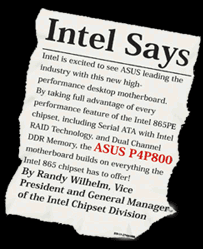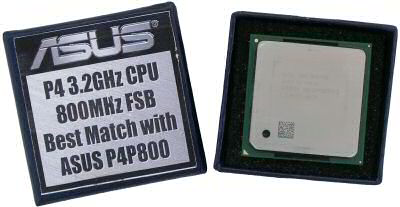 |
||
|
||
| ||
PAT or not PAT - that is the QuestionSome time ago ASUS officially declared that its mainboards based on the i865PE chipset (in particular, P4P800 Deluxe) supported the PAT technology which let them markedly outpace their competitors. After the harsh Intel's response ASUS disavowed it, and the unreal speed of some of their models were explained by the Hyper Path technology. Since the iXBT.com lab tested boards on the new Intel's chipsets, and the scores of the ASUS models were really impressive, we decided to share the facts and our point of view. Chronicle of eventsBeginning of April. We got the ASUS P4C800 Deluxe board based on the Intel Canterwood which wasn't announced at that time yet (future i875P). Being tested on BIOS 1002 beta 021, it shows high scores, much higher than those of the only then i875P based board - Intel D875PBZ. April 14. Official announcement of the Intel 875P chipset. The ASUS P4C800 Deluxe board was used to examine its characteristics and capabilities (see this review). Middle of April. In Moscow and several other cities in the world you could see some boards based on the Intel Springdale chipset (future i865) planned only for the end of May; the board came from relatively small firms and from one large respected company (not ASUSTeK. :) A bit later. Intel harshly (half-officially) criticized those premature announcements and sales of such boards. Very unpleasant sanctions were promised, up to weighty fines and delays in future supplies of chipsets. The sales were rolled up or at least shaded. End of April - beginning of May. New BIOS versions released for some ASUS boards boosted performance of the ASUS P4C800 Deluxe tested before and of the ASUS P4P800 Deluxe which just came (on the unannounced i865PE). Other boards on any of these chipsets performed similarly, and those which first demonstrated low scores were getting closer to the main group with newer BIOS versions. The i865PE/G based boards were just a little faster than those on the i875P, and both groups were far from ASUS's models powered by the new BIOS versions. May 21. Official announcement of the Intel 865 family. In our review the i865PE chipset was represented by the Albatron's board because of too high scores of the ASUS (ASUS P4P800 Deluxe). The scores of the mainboards of ASUS and other companies built on both chipsets will be compared a bit later in this article. Just note that there is a noticeable difference up to 17% in WinAce archiving (advantage of the ASUS i865PE based board over the Gigabyte's board on the i875P). End of May. ASUSTeK officially declared the PAT technology support in its P4P800 line (on the i865PE), which allowed performing better than the competitors. A bit later. Intel denies the PAT support in the i865 chipsets. The half-official claim is pretty soft: the PAT technology is probably supported in the dies but it's locked on the hardware level. (Remember that some enthusiasts have been trying to unlock the multiplier in the Intel processors for over 5 years, and the Hyper Threading technology in the old Pentium 4 processors for half a year already. No effect so far.) A bit later. The scandalous text is removed from the ASUS's site, the announcement made is disavowed, and it's declared that the P4P800 line supports the Hyper Path technology (it's not Hyper Threading!) which allegedly lets these boards score so high results. A little of theory on PATWhat is the PAT technology? As we mentioned in the i875P review, this is not a special technology. Data movement (in a particular case) from the processor into the memory is predictable, and it's possible to determine the cycles. I.e. irrespective of the signal speed in a certain chipset's die on a mainboard examined, data pass through certain queues and buffers, and certain latency values are fixed for their synchronization. You could see something similar when changing memory timings (like CAS Latency, RAS to CAS Delay and others) in the BIOS settings. But different memory modules can work differently in spite the same marking, i.e. they can work at the same clock speeds with the timings being different. Unlike these memory settings, configuration of delays in the chipset depends on the chipset maker and it is determined in special service registers. So, PAT - accelerated data movement through the chipset - is made by programming of respective registers (disabling of some unnecessary intermediate buffers can be applied as well). This technology can't be compared to realization of, for example, ECC support (which needs certain additional hardware). It should be taken into account that the PAT is the only difference of the i875P from the i865PE from the "desktop standpoint" (the second and the last one is the ECC support of the Canterwood). The chipsets are positioned differently, which means that Intel wants the letters P.A.T. be stamped on the memory of those who show interest in Intel's latest product. It's clear that Intel didn't want the abbreviation be mentioned on the same page with the i865PE. Now it's clear what caused the conflict with ASUS. Petty technical details are not interesting for the marketers, that is why the description of the Hyper Path technology is so similar to the Intel's explanation of accelerated data movement through the CPU/memory highway, though it was made for a different chipset. :) The VersionWhat let the ASUS boards perform so well, and can we say that the Hyper Path is PAT? The answer to the second question is simple: no. Intel is the owner of this trade mark, and the right to use it in the i865PE based boards wasn't granted. But the Hyper Path technology actually realizes the idea of PAT, and makes it even better :). Is it a paradox? On one hand, Intel affirms that the i875P employs fast silicon, i.e. special plates with an higher signal speed are selected (or even chips from each plate are selected - it's quite affordable given the release price of the i875P). It thus allows altering the latency. In this case i865 chips may look like cullage, but remember about the Intel's quality and test standards. To ensure flawless operation of its products on the mass production market, the operational limits of all company's products are made stricter. There are a lot of examples: from operation of Tualatin based CPUs on i440BX based mainboards with improper voltage values to i845xE based boards with the official support of processors with FSB 800 MHz (which wasn't officially declared for the chipset). If the guys at ASUS managed to get into configuration of the chipset's parameters, they didn't just accelerated the memory by two clock cycles (according to the official data on PAT). The theory excellently matches the data about approximately equal performance of the P4C800 Deluxe (i875P) and P4P800 Deluxe (i865PE): if it's possible to increase the speed, it should be done on both almost identical chips. The situation is not risky: in contrast to the PAT technology which goes on as the system starts in the FSB800/DDR400 mode or doesn't work at all, the ASUS's acceleration mode is set in BIOS: the menu item is called either Memory Acceleration Mode or Performance Acceleration Mode (it depends on the BIOS version and the board). So, if the system doesn't start when this option is enabled, you have no choice but disable it. It also refers to the memory timings. The only question left is why only ASUS? According to almost official information, Intel disclosed a part of its internal documentation thanks to ASUS's correct conduct in April. The consequences are obvious. It also well agrees with the time of release of the fast BIOS version for the P4C800 Deluxe. Remember that even if the i865PE chip selection takes place for production of P4P800 boards, it can't be the only reason of the breakaway of this board. It looks like that the incident which took place in the end of May didn't affect the relationship between two giants. Anyway, ASUS doesn't put the words Hyper Path there and everywhere in the documentation and in reply gets so cute presents from Intel: 
 As to those who false-started in April, the consequences will probably be well seen at the moment of announcement of the next Intel family. P. S. Test laboratories and realityThe rumor has it that some test labs get special boards from ASUS which
perform much better than other production samples. We've got at least one
argument against it: recently we've received a letter from Germany where
the author (thank you, Oleg!) said that he tested several models
right in the store. The test revealed that the retail ASUS P4P800 board
was much faster than its counterparts built on the i865PE even in games
(however, it's better to use archivers as they are most sensitive to memory
access delays).
Sergey Pikalov (peek@ixbt.com)
Write a comment below. No registration needed!
|
|
Platform · Video · Multimedia · Mobile · Other || About us & Privacy policy · Twitter · Facebook
Copyright © Byrds Research & Publishing, Ltd., 1997–2011. All rights reserved.